Dexter Gaii
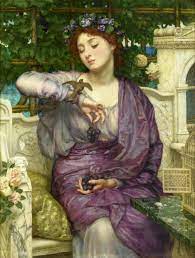
O mi Gaiulle, puto improbam pornam esse tuus dexter.
Ne inhaereas timore irrumare audeat non
Iuppiter. Tenti esse bona ut putes est, sed, bene omnis
Si attollere non potes, requiras virum
Multum annorum usorumque ut laboret tuus dexter.

O mi Gaiulle, puto improbam pornam esse tuus dexter.
Ne inhaereas timore irrumare audeat non
Iuppiter. Tenti esse bona ut putes est, sed, bene omnis
Si attollere non potes, requiras virum
Multum annorum usorumque ut laboret tuus dexter.
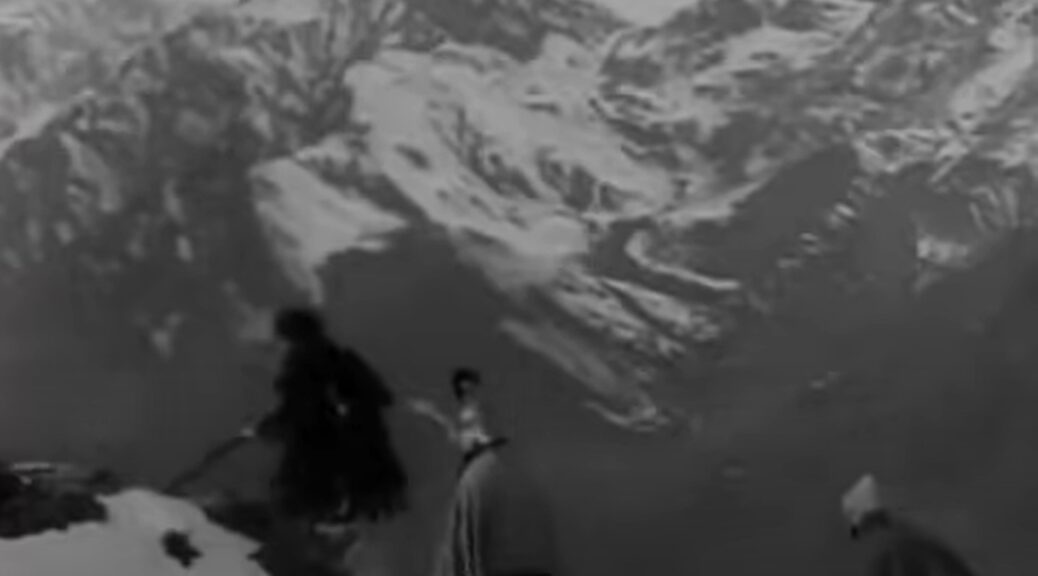
“Cabiria,” a silent film originally released in Italy in 1914, is the story of a little girl abducted and enslaved in Carthage during the Second Punic War. The film opens as Mt Etna erupts, displacing Cabiria, a rich Roman girl, from her home.

Pirates capture Cabiria while she escapes the eruption by boat and bring her to Carthage. In Carthage sell her to a Carthaginian priest to be a child sacrifice to the god Moloch. Her sacrifice is supposed to occur in a fire breathing statue of the god (which is incredibly impressive cinematography).
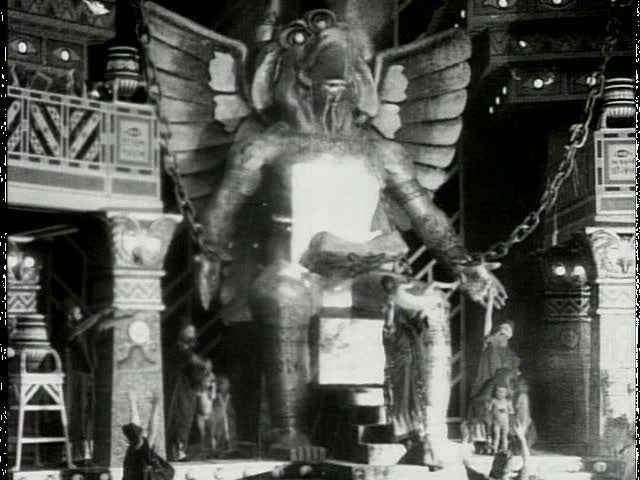
Luckily, Roman spy Fulvius and his slave Maciste save Cabiria and they escape to a nearby inn through the eye of the statue. At the same time, Hannibal marches across the alps incensing the people back in Carthage. Cabiria and her companions must escape from the inn due to a traitorous innkeeper and during their escape run into Sophonisba and Massisina, the daughter of Hasdrubal and the king of Numidia who have been betrothed. Fulvius successfully escapes but Maciste and Cabiria are recaptured.
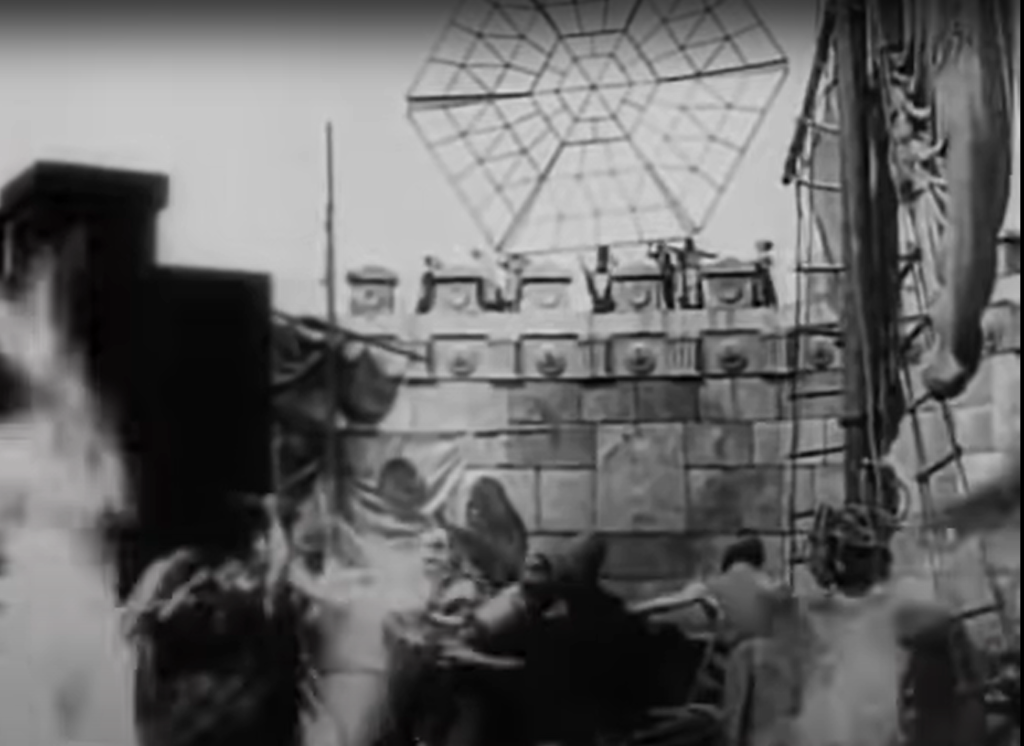
The narrative then shifts to the siege of Syracuse and its defense by the inventions of Archimedes where Fulvius has traveled after he escaped. Archimedes’ laser destroys the Roman fleet and Fulvius is shipwrecked at the new home of Cabiria’s family where he tells them that she is still alive. Fulvius then rejoins the Roman army of Scipio Africanus in North Africa and Scipio sends him back to spy on Carthage, where he sneaks in using a human pyramid.
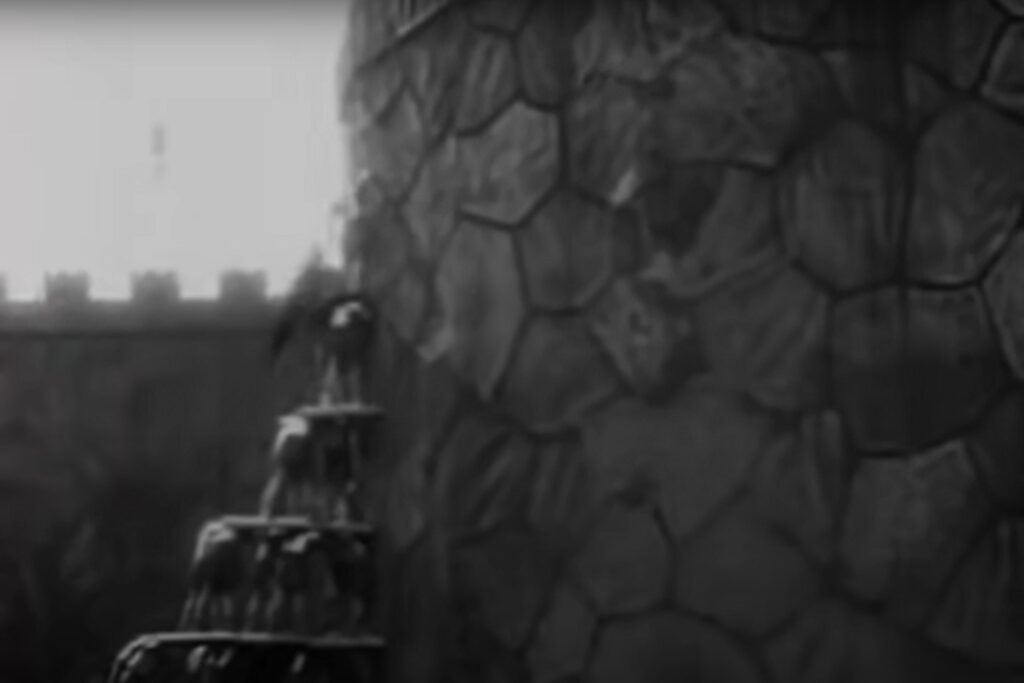
He finds Maciste still trapped as a slave and they escape to find Cabiria. During this time, the Carthiginains and their allies are engaged in an active battle with the Romans. Scipio’s army wins this battle, capturing the nearby city of Cirta with the aid of Massissina, deposed from Numidia and now an ally of Rome. Sophonisba, since married off to the king of the recently captured Cirta, is forced to commit suicide to avoid being treated as a slave by the Romans. Cabiria, a slave to Sophonisba, is freed and returns to Rome with Fulvius as the reign of Carthage has ended.
I really enjoyed watching “Cabiria” and thought it provided an interesting context to the history of Rome and the movie industry. The practical effects in the movie were incredibly impressive for the year the movie came out and the storyline was cohesive and entertaining without the use of dialogue.
“Cabiria” addressed Carthage with a very Roman attitude which harkened back to our discussions in class about the Roman portrayal of Hannibal and Carthage as bloodthirsty and purely militaristic. A similar attitude towards the Carthaginians is evident from the beginning of the movie where Cabiria is supposed to be a child sacrifice to a Carthaginian god. The Carthaginians as a whole in the movie are treated as rather generic villains in a similar fashion to the way they are portrayed in Roman writings.
As I first read about Epicureanism, I had my doubts. At first glance the description does seem to invoke a sense of hedonism, which does not align particularly well with my life style. But upon reading further I can see how the two philosophies differ. I think that there’s a sort of stigmatism around a philosophy that’s based on appreciating all of the good things of life. This is likely because of the way that people are familiar with hedonism. But learning more about epicureanism really allowed me to find distinctions between the two. In many ways, I do live a slightly epicurean style life. I’ve always been an avid enjoyer of good food, which is not always a necessary pleasure but certainly falls into the category of natural yet unnecessary desires. I appreciate the philosophy is centered around enjoyment of life but not in the excess of these pleasures. Appreciating the finer parts of life without over indulging definitely appeals to me and my sensibilities. I like to live generally in moderation because I know that not controlling yourself can be unhealthy, but I like that Epicureanism still finds rooms for pleasure-giving endeavors.
I have definitely found that the simple things in life can be the most fulfilling. Friends, family, nature, and food are some of the things that I enjoy most in life. Based around my understanding of Epicureanism it feels like these fall in line with what they dictate.
I started my week of living philosophically on Monday after class when we were told that we could do the other philosophy as an actum. I was interested in learning more about Epicureanism, especially since I felt that I related to the core philosophy of Stoicism. I found this week to be equally fulfilling but in a different way.
The activity that I found most challenging was the Botticelli “The Birth of Venus” appreciation. Typically, when I visit museums I like to go through them fairly quickly. If a painting or work of art catches my eye I’ll linger for some time, but certainly never for 10 minutes at any time. I’ve always chosen mostly engage with movies, television, or music as my preferred art forms. Paintings as a visual art tend to elude me slightly, as I feel I don’t always get as much out of them as others. Observing the Botticelli painting for a full 10 minute setting definitely did not come easily to me. To be completely honest, if I were to see this painting in a museum I likely wouldn’t have lingered on it for more than a minute. All of this being said I do feel that I gained something from the experience.
I found that I had a greater appreciation for the painting as I was forced to observe every bit of it. At first glance, the painting feels quite simple. There are four visible characters and one clear intended subject. But as you look deeper into it, there’s much more beyond a surface level. I observed the flowers/petals floating around Venus, the details of her seashell, the patterns of the waves behind her. And while all of these were relatively simple as well, they came together to form a pretty beautiful image. I would not have thought that there would be more to find beyond the original look. I think that I’m generally good at finding beauty in simplicity, but as I found out from this activity there’s always more to learn
At the end of the week I came back to this activity again to see what I had gained. While I’m not sure that I found any more detail or beauty than the first time that I performed this activity, I did feel like I already had a greater appreciation for the painting. Obviously there’s only so much that can change in a week, and I’m not saying that I now have a completely altered outlook on paintings, or beauty. But, I think spending so much time with this one painting has given me a very unique relationship to it. I think that in the future I will look through the resources on how to continue engaging with Epicureanism as I truly appreciated this experience.
Word count: 707
For my Roman dish, I decided to make Libum which is described as “ancient roman cheesecake”. Cheesecake is one of my favorite desserts; however, this cheesecake is more like bread with a splash of cheese (ricotta) than our now ‘traditional’ take on cheesecake. Overall, I thought the process of creating the dish was quite simple as you mixed the ingredients to make a soft dough that was then baked. I did, however, go slightly rogue as the amount of flour detailed in the recipe was a slight underestimate of what would be needed. It became a little bit of just doing what feels right, even though my baking experience is vastly limited. I was concerned that adding too much flour may make the final product of the wrong consistency, but I asked one of my roommates for assistance (she is an avid baker) and she confirmed that more flour was indeed needed. Additionally, I was unable to find bay leaves at the grocery stores I stopped at, so I had to omit them from the recipe. Luckily, I do not think either of these self-implemented renditions to the recipe impacted the final taste of the Libum.
Once the Libum had finished backing and the aroma had filled our tiny on campus kitchen, my roommate came back out of her bedroom noting how amazing it smelled. While we both agreed the ancient cheesecakes smelled quite devine, I was hesitant to taste test as the ingredients seemed like an odd pairing. While I love bread and ricotta. Ricotta baked into my bread was something I was unfamiliar with. And after the extra addition of more flour, I was also worried the consistency would be a little messed up. Unfortunately, the final taste was a little bit less of a wow than the aroma, but the consistency of the bread was quite nice (kudos to my roommate). We all agreed that the ancient roman cheesecakes were a little bland and were overpowered by the amount of honey that the recipe called for. If I were going to make this dish again, I think I would serve it with ice cream of some sort, maybe vanilla and then drizzle with caramel.
Pompeii follows gladiator Milo in Pompeii before the eruption of Mount Vesuvius. The movie opens with a brutal slaughter of Milo’s parents by Senator Corvus’ troops when he was a kid. Years later, he is sold to fight in Pompeii. On his way, he encounters Cassia, who thanks him for putting a fallen horse out of misery. In Pompeii, Milo meets Atticus, a fellow gladiator, and after initial hostility, the two eventually become allies. The gladiators are shown at a dinner party attended by Cassia and her family. Milo sees Cassia again but they are unable to talk until Milo calms Cassia’s horse after rumbles from Vesuvius frightens it. The pair take a ride in the countryside but encounter Roman soldiers, who bring the pair back to Pompeii. Throughout the movie, the pair deal with the corrupt Senator Corvus, who aims to kill Milo and marry Cassia against her will. During a gladiator fight, Corvus nearly issues a kill order on Milo and Atticus, but Cassia prevents their death and is locked in a room. After this fight, the arena begins to crumble as Vesuvius erupts. While most people attempt to escape, Atticus and Milo rush to free Cassia. Atticus later kills Proculus, the second in command of Corvus and is killed by the eruption. Milo and Cassia flee, but realizing their futile attempt, dismount their horse and kiss as they are smothered in ash.
Overall, I found the movie a bit predictable and overdramatized. As someone who does not enjoy violent movies, I did not like the vividness of the stabbings. Multiple times I turned away as people’s heads were cut off or they were stabbed in the abdomen. I liked how the characters did not like the Romans, as it was a different perspective than we look at in class. While we focus on the splendor of Rome’s military conquests, we tend to ignore the people who were killed for and resent Rome. While I thought Milo and Cassia’s connection was superficial and unrealistic, I liked the relationship between Milo and Atticus. Milo has become unemotional out of necessity. His initial hostility towards Atticus is warranted, as it is Milo’s nature to refuse connections with those he will kill. The relationship between these two appears to be the only major substantial relationship in the film.
My roommate, who also watched the movie, did not mind the violent scenes. She found that although there were obvious historical inaccuracies and the love plot seemed unrealistic, it did add a humane aspect to the mass death. She later questioned if there actually were people found kissing after being buried, as portrayed in the movie. She is now researching Pompeii videos on Youtube to find out.
Word Count:454
The movie Spartacus is about the aptly named Spartacus, a rebellious slave who slowly became one of the most feared enemies for the Romans, leading slave rebellions and freed slaves to battle against the Roman army.
The movie starts with Spartacus being sentenced to death by starvation and then was bought as a slave by Lentulus Batiatus. After some suffering as a slave, Spartacus was forced into a fight to the death along with 3 other people. From there, he was almost killed, but was spared by his opponent when he was spared and his opponent tried to kill people in the audience. We then see Spartacus lead a rebellion by killing Marcellus and starts a fight which leads into an all-out slave rebellion. The rebellion was successful and led to Spartacus leading the newly freed slaves to the Italian countryside.
Due to his battle prowess and ability, he became the leader of the newly formed group and start their journey around Rome, taking everyone home. On the way, they start pillaging Roman estates and growing the army in the process with more slaves joining the cause. This leads to the Roman leaders noticing all of this happening and forcing them to take action against this growing army.
After a while, Spartacus and the slave army are forced to fight the Roman army and were initially able to hold off some of the forces, but were eventually beaten handily. Then as an attempt to find out the leader, the Romans try to get the army to surrender Spartacus, but all of what was left of the army didn’t give him up and all responded to the Romans by saying “I am Spartacus”. Because of this, all of them were sentenced to death. Upon being captured, Spartacus was forced to fight one his allies, Antoninus, and killed him in the end. After that, Spartacus was eventually crucified.
Reflecting on this movie, there were some topics that we learned about in class were seen in the movie. Negotiations involving transactional friendships was a highlight of one of the things we learned in class and was something that I noticed while watching the movie with friends. One other thing that I noticed in the movie was the “I am Spartacus” scene where it showed a sense of belonging to the freed slave army, which was something involved in one of the reflection assignments.
Better than revenge by taylor swift reimagined with the story of the Assassination of Julius Caesar . “Better than Julius”: ileana rodriguez
The movie begins with General Maximus defeating Germanic tribes. He then wishes to return to his family, but is told by the emperor, Marcus Aurelius, that his son Commodus is unfit to succeed him. Marcus Aurelius asks Maximus to succeed him as emperor to save Rome. Commodus finds out about this and kills his father. Commodus names himself emperor and arrests Maximus. Maximus escapes but returns to his home to find his family has already been killed. He is then captured and forced to become a gladiator. Maximus does well as a gladiator in North Africa, and is sent to Rome to fight in the Colosseum for the gladiator games that Commodus puts on to commemorate his father’s death. Maximus is dressed as a Carthaginian to re-enact the battle of Rome vs. Carthage. Using his military skill and strategy, Maximus is able to lead his team of gladiators to victory. Maximus reveals himself to Commodus and is saved by the crowd. Maximus’ next fight is against an undefeated gladiator. He wins and spares the life of his opponent, defying the orders of Commodus. Maximus then meets with an old friend from the army and devises a plot to take back control of Rome from Commodus. Commodus then challenges Maximus to a public duel. Maximus defeats Commodus in combat, but ultimately succumbs to his wounds. Before Maximus dies, he asks for political reforms, and is honored as a soldier of Rome.
Overall, I really enjoyed this movie. I thought that it did a good job of portraying Ancient Rome while also delivering as an entertaining blockbuster movie. I thought that it was really interesting to see Maximus in the role of Hannibal, as a leader who was able to use superior strategy and skill to defeat Roman soldiers. Another important part of the movie was its portrayal of pursuit of individual glory versus service to the state of Rome. Commodus is clearly portrayed as the villain due to endless pursuit of power, glory, and status for himself. He has no desire to serve Rome, he only wants to further his own agenda. Meanwhile, Maximus is the ideal Roman soldier. He is not loyal to any one man, he fights in service to Rome.
The movie begins with Spartacus biting a Roman soldier’s ankle in an act of defiance. He is sentenced to death by starvation. While he is left out to die, he is seen by a Roman named Batiatus, who owns a gladiatorial school. Batiatus is impressed with Spartacus’ spirit and purchases him to become a gladiator. While at the gladiatorial school, Spartacus is trained to become a gladiator by Marcellus and meets Varinia. Next Crassus shows up at the gladiator school, purchases Varinia, and arranges for Spartacus and three other gladiators to fight to the death. Spartacus’ opponent, Draba, refuses to kill Spartacus and is ultimately killed by Crassus. The next day Varinia is taken to go to Crassus’ house in Rome. Marcellus taunts Spartacus over Varinia, which leads to a riot, and Spartacus and the gladiators escape. Spartacus becomes their leader, and many other slaves join with them, including Varinia, who escaped, and Antoninus, an ex-servant of Crassus.
Spartacus and his men defeat the Roman garrison sent to destroy him, led by Glabrus. The Roman Senate panics and gives power to Crassus. Crassus bribes the pirates who were going to help Spartacus escape, and Spartacus is forced to turn north towards Rome. Crassus’ army meets Spartacus’ and wins. Crassus attempts to identify Spartacus among the survivors, but all the survivors refuse to help, instead shouting “I am Spartacus!” Crassus then sentences them all to death by crucifixion. Crassus also takes Varinia, who has given birth to Spartacus’ son. When Varinia rejects him, he seeks out Spartacus and forces him to fight Antoninus to the death. Spartacus kills Antoninus to spare him from crucifixion. The movie ends with Varinia escaping Rome and meeting the crucified Spartacus on the Appian Way, who dies knowing that his son is free.
One topic that we discussed in class that came up in this movie is the Roman conception of friendship. Early in the movie Spartacus attempts to befriend Draba in the gladiatorial school by getting to know him. This is a nontraditional conception of Roman friendship since there was no transactional element and neither gained anything socially from the friendship. A more traditional sense of Roman friendship is seen between Batiatus and Gracchus, Crassus’ main opponent in the Senate. Batiatus and Gracchus have a friendship because they are each able to gain something. Gracchus is able to use Batiatus’ information about Spartacus and Varinia to attempt to take down Crassus, and Batiatus is able to use Gracchus’ influence to get back at Crassus for causing the destruction of his gladiatorial school.
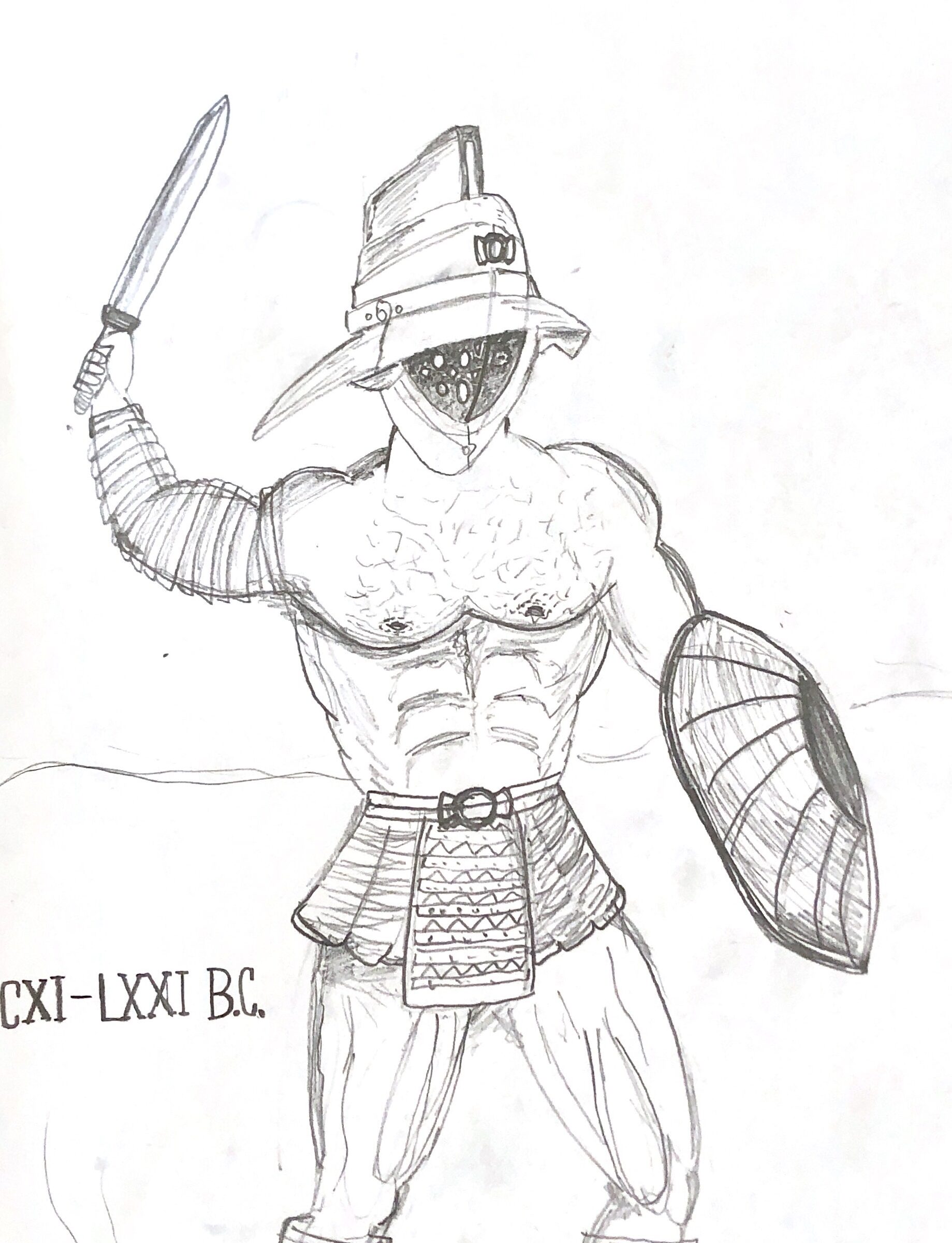
For this actum I have chosen to draw a depiction of the roman gladiator, Spartacus. Spartacus is famous for leading the third servile revolt in 73 B.C. against the Roman Republic. It was ultimately unsuccessful and he was killed in 71 B.C. Spartacus was a heavy weight gladiator called a Murmillo. The drawing remains consistent with the historical descriptions of this type of gladiator. Murmillos carried a gladius, which was a sword of about 18 inches, used to both slice and cut its opponents. The arm holding the gladius was protected with a Manica, which was a protective sleeve made of leather or metal. On the other hand, they carried a Scutum, which was a long rectangular shield similar to the type used in the roman army. Murmillos would wear a Cassis Crista on their heads, which was a helmet with a broad rim and a protective face grill. On their shins, Murmillos would wear an Ocrea, which was a shin guard usually made of some type of metal. Lastly, these gladiators would wear a Balteus, which was a leather belt, similar to a weight lifting or boxing belt. Due to all of the heavy equipment, the success of these gladiators largely relied on their strength, which is why Spartacus is depicted here with large and defined muscles.